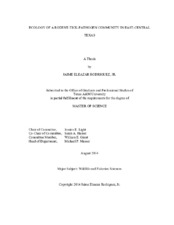| dc.description.abstract | Rodent species worldwide are critical to the maintenance of tick-borne disease systems because they serve as hosts for ticks and reservoirs for zoonotic pathogens. To learn more about native fauna that may be involved in enzootic transmission of pathogens that can cause tick-borne diseases (TBDs), a mark-recapture study of rodents was conducted in Brazos County in east-central Texas. My objectives were to: (i) describe the species richness and seasonal activity of rodents; (ii) characterize rodent infestation with ticks over time; and (iii) determine the infection prevalence of rodents and ticks with selected zoonotic tick-borne pathogens.
For nineteen months, small mammals were live-trapped two nights per month and subjected to blood and ear biopsy collections. All captured mammals were checked for the presence of ticks, which were removed for diagnostic testing. Additionally, drag sampling was conducted to collect ticks from the vegetation.
Five rodent species (Sigmodon hispidus, Reithrodontomys fulvescens, Peromyscus leucopus, P. gossypinus, and Baiomys taylori) were captured over the course of the study. A large increase in S. hispidus capture success was seen in fall 2013, reflecting the characteristic population booms exhibited by this species. Two tick species - Amblyomma maculatum and Ixodes scapularis - were found infesting the rodents at low levels (2.33%). No ticks were found in over 14,500 meters of drag sampling the vegetation.
In an analysis of 698 ear biopsies, 3.2% of the specimens were positive for Borrelia miyamotoi, a spirochete that has recently been shown to cause relapsing fever in humans. One specimen (0.1%) was found to be infected with B. lonestari. No ticks were found to be infected with Borrelia. However, 4.3% of the larval A. maculatum pools were positive for a rickettsial endosymbiont. One larval A. maculatum pool and one I. scapularis nymph were found to be infected with Rickettsia monacensis, the causative agent for a Mediterranean spotted fever-like illness in Europe and North Africa. This study identifies novel TBDs in the southern United States and exposes the need for further study of TBD ecology, especially in understudied areas. | en |


